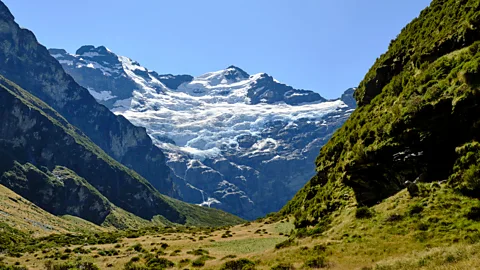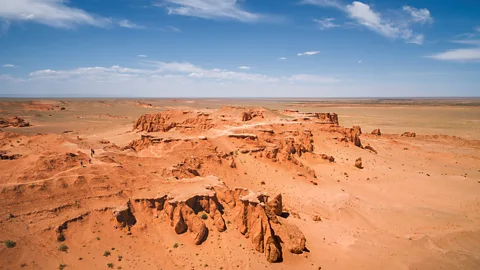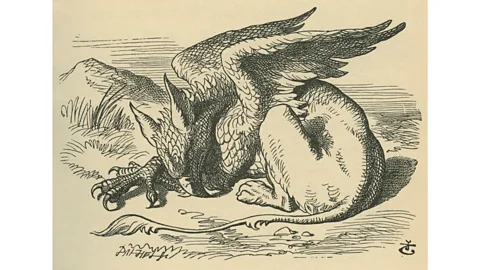The myths that hint at past disasters
 JMW Turner/Getty Images
JMW Turner/Getty ImagesMyths and fables passed down over thousands of years are full of fantastic creatures and warring gods. But they also might contain evidence of environmental disasters of the past.
For those affected, it could seem like the end of the world. Residents of Stinson Beach, a popular tourist destination near San Francisco, are coming to terms with studies that show large parts of their neighbourhood will be under a foot of water in less than 20 years. The affluent are able to build homes on raised foundations and afford expensive sea defences that will hold the water back, at least for a while, but the poor will have to accept the loss of their homes or find some way to move them to higher ground.
We may believe the 21st Century is the first time our species has faced this kind of tragedy, but it is not. Sea levels started to rise nearly 15,000 years ago with the end of the last ice age. The melting land ice caused sea levels to rise on average around 360ft (120m) between now and then – at times it was more like an inundation, with the water rising so quickly that people would have been caught in a desperate struggle to stay ahead of it and somehow cope with the enormous effect it wrought.
With the possibility of a catastrophic global sea level rise of 3ft (1m) by 2050 which could force millions of people to leave their homes, researchers have now started to look at ancient stories about land lost to the sea and downed cities in a new way. These aren’t always just good stories, full of poetry and symbolism, but vessels that transmit the collective memory of those that lived through it, and inside which there may be factual evidence as to what might have happened thousands of years ago when the ice sheets melted.
You might also like:
Some researchers argue that tales of hot boulders thrown into the sea or the building of sea walls comprise factual information, albeit exaggerated and distorted to some extent. They give us insight into how our ancestors felt about the rising sea levels and what they did about it, and they can provide evidence that their response was remarkably similar to ours. The insights of ancient peoples may in fact save lives in the future.
These researchers are geomythologists. American volcanologist Dorothy Vitaliano coined the term in a 1967 lecture (basing her ideas on those of the Ancient Greek philosopher Euhemerus, who set out to find the real events or people behind popular myths. While geomythologists’ research into the origins of the legend of Atlantis or the myth of the Loch Ness monster may grab the headlines in a sensationalist manner, it is their job is to study ancient stories once regarded as myths or legends, but which are now seen as possible observations of natural phenomena by pre-literate peoples.
 Paul Chinn/Getty Images
Paul Chinn/Getty Images“Geomyths represent the earliest inklings of the scientific impulse,” says Adrienne Mayor, folklorist, historian of ancient science and research scholar at Stanford University, California, and author of the important The First Fossil Hunters, “showing that people of antiquity were keen observers and applied the best rational, cohesive thinking of their place and time to explain remarkable natural forces they experienced.”
Today, the growing number of published papers, citations and Google search results show interest in such work is growing in the scientific community. Such events as volcanoes in early human history or even Biblical themes, such as how volcanoes, earthquakes and plagues may have shaped the story of the Exodus found in the Hebrew Bible.
Geologists have started to realize that there's actually information in some of humanity's oldest traditions and stories,” says David Montgomery from the University of Washington, author of The Rocks Don't Lie: A Geologist Investigates Noah's Flood,“and that while it's of a different type of information than we tend to gravitate towards in contemporary science, it is still information”.
Yet time is running out for many geomyths, and the local knowledge they contain risks being degraded and lost. “In the Pacific Islands, old people are forever complaining to me that the young people are always on their phones, and that they really don't want to hear their grandparents’ stories,” says geologist Patrick Nunn, a professor of Geography at the University of the Sunshine Coast, and author of the new book Worlds in Shadow: Submerged Lands in Science, Memory and Myth. “But I think everywhere in the world, as oral societies are becoming largely literate, knowledge that has been held orally is disappearing, yet it is this indigenous knowledge that is going to help them cope with sea level rise.”
Nunn is one of the world’s leading geomythologists. A trained geologist, he can usually be found in the international uniform of shorts and a t-shirt, on a small boat sailing between the islands that dot the Pacific Ocean, voice recorder in his hand. His research has focused on some of the stories about vanished islands like Teonimenu, that occur all over the islands scattered across the vast Pacific.
 Jorge Fernández/LightRocket/Getty Images
Jorge Fernández/LightRocket/Getty ImagesFor his latest research project, Nunn didn’t have to get his feet wet. He has been examining thousand-year-old stories from Australia and Northwest Europe about how ancient peoples made sense of, and responded to, their different experiences of post-glacial sea level rise. Significantly, along the Australian coast, the sea level stopped rising about 6,000 years ago, whereas it has continued in northwest Europe until the present day.
In nearly all of the 23 groups of Aboriginal Australian stories Nunn studied, the memory of the changes in landscape and way of life caused by post-glacial sea level rise seems to have been preserved from 7,000 years ago. In two particular groups, their resistance appears to be evident.
One such story, told by the Gungganyji Aboriginal people around Cairns on the Queensland coast, is found in different versions across northeast Australia. In this story the bad behaviour of a man named Goonyah caused the sea to flood the land and he then organised the people to stop it. In another, he led the people up a mountain to escape the water where they worked together to roll heated rocks into the sea. By so doing, they succeeded in stemming its advance.
In northwest Europe, the stories that Nunn and his collaborators studied are naturally quite different. These 15 or so stories are focused on the fate of drowned cities, each with a different name, and they are concentrated along the coast of Brittany, the Channel Islands, Cornwall and Wales – areas where, Nunn says, “cultural continuity” may have been greatest over the last few thousand years. In two of the stories, the city’s elaborate defences imply the inhabitants had been fighting a losing battle against the sea for generations.
In Brittany, the story is about the city of Ys, ruled by King Gradlon, which was protected by a complex series of sea defences that required gates to be opened at low tide to allow excess water to drain off the land. One day, the king’s daughter, Dahut, possessed by a demon, opened these gates at high tide, allowing the ocean to flood the city, and led to the abandonment of the city. In west Wales, a similar story is told about the fate of the city of Cantre’r Gwaelod in Cardigan Bay.
 Sevrette J/UIG/Getty Images
Sevrette J/UIG/Getty ImagesThe detective work doesn’t stop there. Nunn has been able to reconstruct the coastlines mentioned in the stories, and from knowledge of past sea level changes, put a minimum age on these stories of 6,000–8,000 years.
“One thing that we can learn from these ancient stories is that sea level rise cannot be stopped very easily by sea defences like sea walls,” says Nunn. “The only long-term solution is transformative solutions, which really involve people taking themselves out of the danger zone.
“The other thing I think we can learn is that the most effective types of adaptations to these kinds of environmental stresses are locally based ones. This is something that science has really only worked out in the last five years, but if you go back 7,000 years, you can see that people took action locally, and they believed in its efficacy, and they drove it by themselves. They didn't wait for instructions from elsewhere.”
Despite the growth of geomythology, it is still seen as “flaky” by some academics. “Probably an element of stodginess on the part of scientists and historians still figures!” says Mayor. “But geomythological stories are expressed in poetic metaphors and mythic or supernatural imagery, and descriptions of catastrophic events and natural phenomena can be garbled over millennia, and because of this scientists and historians tend to miss the kernels of truth and rational concepts embedded in their narratives.”
Nunn puts this argument more strongly. “I'm a conventionally trained geologist and I can tell you that a lot of other conventionally trained geoscientists really don't like this kind of thing. There's a lot who are curious about it, but by and large, it's something that is considered so radical that people really don't want to consider it.
 R M Nunes/Getty Images
R M Nunes/Getty ImagesLiterate people are also inherently sceptical about the power of oral traditions to pass things down across the across hundreds of generations.”
There can be other issues. Academics taking the stories of indigenous people and publishing research about them can easily lead to accusations of cultural appropriation if they don’t follow simple good practice like asking permission first.
Geomythology has faced a long journey to even become considered by the scientific establishment, and the journey is far from over. A year after Dorothy Vitaliano first used the term, she wrote in the Journal of the Folklore Institute that geomythology is the “geological application of euhemerism”, and that geomythologists could “help convert mythology back into history”, and five years after that she published her groundbreaking book, Legends of the Earth (1973). Sadly, it is now out of print.
It took three decades of rising interest in the field before the 32nd International Geological Congress held its first ever session on geomythology in 2004, at which the by-then elderly Vitaliano delivered the keynote to ”250 people in a room booked for about 100 people”. The volcanologist died four years later after seeing the first ever peer-reviewed collection of papers on the subject, Myth and Geography, published in 2007.
“It took a lot of courage for her to publish her book way back in the 1970s, and she was kept at arm's length by a lot of geologists for a long, long time,” says Nunn, who spoke after Vitaliano at that event. “It was the 2004 session at the International Geological Congress that really helped to validate geomythology in the minds of many scientists.”
The field Vitaliano founded has started to evolve. It may have taken Mayor 20 years to research and write The First Fossil Hunters (2000), but the book she delivered created the new concept of “fossil myths” because it was the first systematic study of the evidence for the ancient discovery of fossils. Famously, Mayor made the connection between Greek and Roman descriptions of the mythical griffin, which she thought sounded like eyewitness accounts, and the amazing dinosaur fossils that can be found on the surface of the Gobi desert, near the Silk Road, the route that caravan trains used to connect Europe and China.
 Culture Club/Getty Images
Culture Club/Getty ImagesHer latest research includes working with Lida Xing, a palaeontologist in China, on how Chinese oral traditions about mythic creatures account for local dinosaur tracks.
In May 2021, Timothy Burbery’s Geomythology: How Common Stories are Related to Earth Events will hit the bookshops to become geomythology’s first textbook. “Mayor took geomythology to the next level, by not looking only at geological events, but the palaeontological ones as well,” says Burbery, professor of English at Marshall University, West Virginia, “and really getting a sense of just how traumatic it would have been for ancient people to find the bones of some strange, huge animal.”
In the end, geomythology challenges our way of thinking about our past, and our future. “Geomythology challenges the belief that all myths and legends are only fictions and fantasy,” says Mayor. “Geomyths are treasuries of information and details for the physical sciences that would otherwise be missed.”
New geomyths may even be created for future generations to pore over. “I imagine that global warming and climate change and rising sea levels might inspire new geomyths,” she says.
“The most important lesson is that we will survive,” says Nunn. “It doesn't mean that we aren't going to have to adapt, in many cases quite radically, to accommodate the effects of climate change. But it does mean that we will survive it.”
--
If you liked this story, sign up for the weekly bbc.com features newsletter, called “The Essential List”. A handpicked selection of stories from BBC Future, Culture, Worklife, and Travel, delivered to your inbox every Friday.
